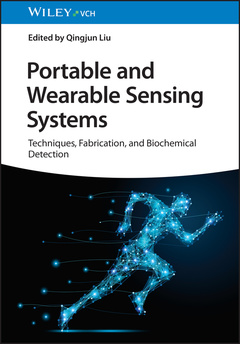Description
Portable and Wearable Sensing Systems
Techniques, Fabrication, and Biochemical Detection
Coordinator: Liu Qingjun
Language: English
Subjects for Portable and Wearable Sensing Systems:
· 17x24.4 cm · Hardback
Description
/li>Contents
/li>Biography
/li>
Discover the sensors of the future with this comprehensive guide
Chemical sensors and biosensors have advanced enormously in recent decades, driven by growth in other technological areas and the refinement of manufacturing processes. Advances, especially, in wireless technology and flexible electronics have dramatically increased the practicality and availability of portable or wearable sensing systems. These have the potential to revolutionize disease diagnosis, food analysis, and environment monitoring at the point of care.
Portable and Wearable Sensing Systems: Techniques, Fabrication, and Biochemical Detection introduces these groundbreaking technologies and the underlying principles which make them possible. Beginning with an overview of the foundational optics and electrochemistry which power these systems, the book surveys methods of fabrication, applications, and projected future developments. The result is a comprehensive introduction to an essential medical and biochemical technology.
Portable and Wearable Sensing Systems readers will also find:
- Treatment of body fluid detection, exhaled breath sensing, ingestible devices, and more
- Detailed discussion of sensing system types including scattering, colorimetric, and chemiluminescence
- Forward-looking attention to the latest advances in every chapter
Portable and Wearable Sensing Systems is ideal for analytical chemists, materials scientists, bioengineers, biochemists, and anyone working with sensing technologies.
Preface xi
1 Portable and Wearable Sensing Technologies for Biochemical Detection 1
Xin Li, Fenni Zhang, and Qingjun Liu
1.1 Biochemical Detection: Increasing Demands and Challenges 1
1.2 Portable Sensing Technologies: Efficient Biochemical Analysis 2
1.3 From Portable toWearable: Toward In Situ Biosensing 4
1.4 Summary and Outlook 12
2 Portable Electrochemical Sensing Systems 19
Zijian An, Yue Wu, Yuting Zhao, Yanli Lu, and Qingjun Liu
2.1 Fundamentals of Portable Electrochemical Sensing Systems 20
2.2 Techniques of Portable Electrochemical Measurement 25
2.3 Fabrication of Portable Electrochemical Systems 28
2.4 Applications of Portable Electrochemical Sensing Systems 31
2.5 Summary and Outlook 35
3 Portable Optical Sensing Systems 41
Jinbiao Ma, Jiahao Xu, Baiqi Cui, Dehong Yang, Ying Fang, Xiaoyin Liu, and Fenni Zhang
3.1 Fundamentals of Portable Optical Sensing Systems 41
3.2 Plasmonic Sensing-Based Portable Optical Systems 42
3.3 Scattering Sensing-Based Portable Optical Systems 49
3.4 Chemiluminescence Sensing-Based Portable Optical Systems 54
3.5 Colorimetric Sensing-Based Portable Optical Systems 57
3.6 Summary and Outlook 62
4 Portable Optical-Electrochemical-Coupled Sensing Systems 71
Zetao Chen, Fenni Zhang, Yanli Lu, and Qingjun Liu
4.1 Fundamentals of Optical-Electrochemical-Coupled Sensing Systems 72
4.2 Optical-Electrochemical-Coupled Sensing Techniques 73
4.3 Fabrication of Optical-Electrochemical-Coupled Electrodes 77
4.4 Construction of Portable Optical-Electrochemical-Coupled Systems 81
4.5 Summary and Outlook 85
5 Smartphone-Based Portable Sensing Systems for Point-of-Care Detections 89
Guang Liu, Yue Wu, Yutian Wang, Weihong Ye, Minyang Wu, and Qingjun Liu
5.1 Smartphone-Based Optical Sensing System 90
5.2 Smartphone-Based Electrochemical System 94
5.3 Smartphone-Based Photoelectrochemical (PEC) System 99
5.4 Smartphone-Based Point-of-Care Detections 101
5.5 Summary and Outlook 103
6 Flexible Electronics for Wearable Sensing Systems 111
Qi-Qi Fu
6.1 Flexible Electronics: Definition and Development 112
6.2 Advantages of Flexible Electronics inWearable Sensing 112
6.3 FabricatingWearable Sensing Systems with Flexible Electronic Technologies 113
6.4 Wearable Sensing Systems Fabricated by Using Flexible Electronic Technologies 125
6.5 Summary and Outlook 129
7 Wearable Sensors for In Situ Biofluid Analysis 139
Zhenghan Shi, Chaobo Dai, Feiyue Fang, Yifan Shuai, Chuhan Xiong, and Qingjun Liu
7.1 Wearable Sensors for Sweat Analysis 140
7.2 Wearable Sensors for Saliva Analysis 145
7.3 Wearable Sensors for Interstitial Fluid (ISF) Analysis 149
7.4 Wearable Sensors for Tear Analysis 151
7.5 Summary and Outlook 152
8 Wearable Sensors for In Situ Breath Analysis 157
Jingjiang Lv, Xin Li, Jingying Pan, Rujing Sun, Yanli Lu, and Qingjun Liu
8.1 Wearable Breath Sensors for Physiological Monitoring 157
8.2 Wearable Breath Sensors for Volatile Markers Analysis 162
8.3 Wearable Breath Sensors for Virus Detection 170
8.4 Summary and Outlook 174
9 Wearable Sensors for Wound Diagnosis and Close-Loop Therapeutics 179
Lihua Peng, Jinyu Zhao, and Minhong Tan
9.1 Wearable Sensors forWound Monitoring 180
9.2 Wearable Drug Delivery forWound Treatment 186
9.3 IntegratingWearable Sensors withWearable Therapy 190
9.4 Close-Loop Therapeutics withWearable Devices 197
9.5 Summary and Outlook 200
10 Self-Powered Sensors for Wearable Detections 207
Yang Zou and Zhou Li
10.1 Biofuel-Based Sensors 208
10.2 Thermoelectric Nanogenerator-Based Sensors 212
10.3 Triboelectric Nanogenerator-Based Sensors 215
10.4 Piezoelectric Nanogenerator-Based Sensors 220
10.5 Summary and Outlook 224
Acknowledgments 226
References 226
Index 233
Qingjun Liu, PhD, is Professor of the Biosensor National Special Laboratory and Director of the Biomedical Engineering Institute, Zhejiang University, China. He is also the member of Steering Committee of Biomedical Engineering in Colleges and Universities of the Ministry of Education of People's Republic of China, and member of the China Micron Nanotechnology Society. His interests mainly focus on biomedical sensing and detection research, especially in wearable and portable sensing technologies.
These books may interest you

Wearable Bioelectronics 193.44 €



